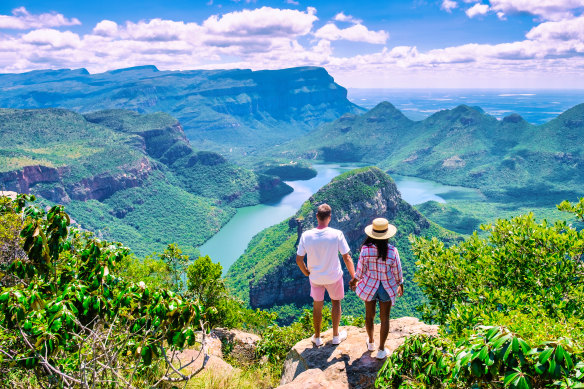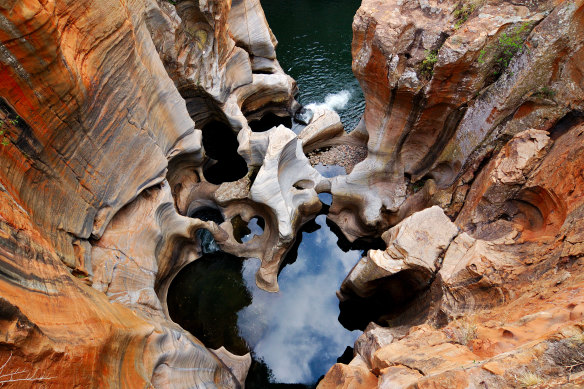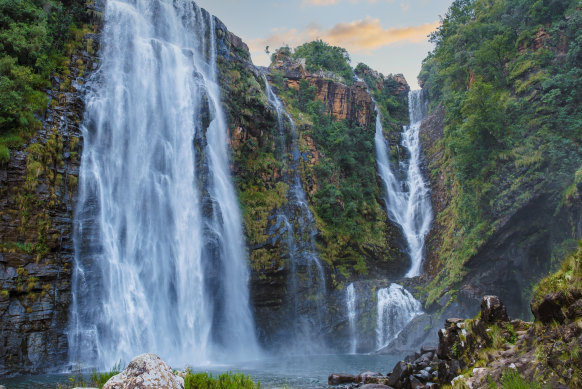The spectacularly scenic South African drive most people miss
It’s a good problem to have. When you’re one of the world’s premier wildlife destinations, home to a national park so well-known that most people refer to it simply as “Kruger”, it’s understandable that you might not boast about your country’s natural attractions. Aside from Cape Town’s Table Mountain, most people would struggle to name another notable South African natural landmark.

Looking into the Blyde River Canyon on the Panorama Route.Credit: iStock
All of which makes the Panorama Route an unexpected delight. Located west of Kruger in the Mpumalanga province, it’s both a spectacularly scenic driving route and the gateway to a series of dramatic geological wonders.
Like many visitors, we experience it during a transfer between two safari lodges. We could have taken a quicker, more direct option, but our tour operator, Australian-owned specialist This is Africa, knows from experience that the Panorama Route provides a welcome scenic interlude between days spent bouncing around in safari Jeeps.
After snaking up the flanks of the Drakensberg escarpment to reach the high-elevation Central Plateau, we turn onto the R532, the most popular section of a network of roads that comprise the Panorama Route.
Our first stop is arguably the route’s highlight, Blyde River Canyon, a plunging 26-kilometre gorge carved by the Blyde River that’s unusual in that it’s almost completely smothered in subtropical vegetation, hence its claim to be the world’s largest “green” canyon.
One particularly striking feature is the Three Rondavels – three cylindrical quartzite hills with conical tops that resemble a trio of traditional rondavel thatched huts.
Next is Bourke’s Luck Potholes, a bizarre topographical feature at the start of the canyon where the Blyde and Treur rivers meet. Over countless millennia, sand and pebbles carried by the swirling currents have ground out distinctive circular potholes in the sandstone bedrock. Accessed via a network of pedestrian walkways and ravine-hopping bridges, the phenomenon looks like a giant has attacked the canyon with an enormous ice-cream scoop.

The Potholes sculpted by constant movement where the rivers meet.Credit: iStock
The site is named after prospector Tom Bourke, who came to the area in the 1880s looking for gold. Despite there being plenty of it around (the area erupted in gold rush fever a few years later), by all accounts he never found any. Presumably, the site’s name is an ironic reference to his lack of good fortune.
After a tasty pulled-pork vetkoek (a kind of doughy fried bread sandwich) at The Chubby Pig, a porcine-themed cafe on the banks of the Treur River, we head towards Lisbon Falls, one of the tallest of the many waterfalls that tumble down the area’s many cliffs, bluffs and escarpments. Enroute, we get our first taste of the high-elevation plateau’s defining weather condition, fog, which according to our guide occurs about 50 per cent of the time.

Lisbon Falls – the highest waterfall in Mpumalanga.Credit: iStock
It rolls in like a ghostly grey tsunami, silently smothering everything in its path. There’s a brief respite at Lisbon Falls, allowing us to admire its impressive twin torrents as they leap 92 metres into the ravine below, but it closes in again as we approach God’s Window.
On a clear day, God’s Window apparently delivers hallelujah-inducing views of a 700-metre-deep forested ravine that opens to a vast expanse of lowveld that stretches to the Mozambique border. Today, the fog is so bad, we don’t even bother to stop.
Normally, I’d be disappointed, however the fog means we’re also unable to experience the region’s top adrenaline drawcard: the Big Swing, a terrifying-sounding 20-storey roped plummet into Graskop Gorge that I’ve been concocting excuses to get out of all week. It’s the region’s one natural landmark that I’m happy to admire from afar.
THE DETAILS
TOUR
African specialist This is Africa has almost 25 years’ experience and offers all-inclusive packages, group tours and tailor-made itineraries. See thisisafrica.com.au
STAY
Spectacularly located on the edge of the Drakensberg escarpment, Angels View hotel has spacious, well-appointed rooms, three pools and – weather-permitting – horizon-straining views over the lowveld. From R1607 ($130) a person twin share, including breakfast. See angelsview.co.za
FLY
Qantas flies to Hoedspruit via Johannesburg in conjunction with Airlink. From Hoedspruit Airport, it’s a 60-minute drive to the northern end of the Panorama Route (R532). See qantas.com
MORE
southafrica.net
The writer was a guest of South African Tourism and This is Africa.
Sign up for the Traveller Deals newsletter
Get exclusive travel deals delivered straight to your inbox. Sign up now.